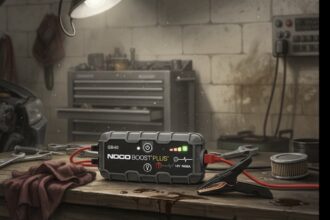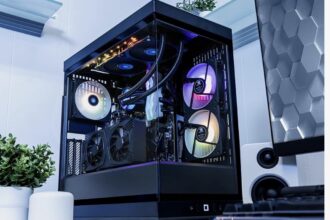Digital Air Compressor (12V Portable Tire Inflator with LED) — Full Review
A complete, practical guide to the common 12V digital tire inflator you can keep in your car. This review covers how it performs, realistic test scenarios, tips for safe use, troubleshooting, maintenance, and aggregated user feedback.
Quick verdict — short summary
Portable 12V digital air compressors are one of the best value automotive accessories you can carry. They won’t replace a garage compressor for heavy-duty jobs, but for roadside emergencies, topping up tires, inflating bikes or sports gear, they’re fast, convenient and often life-saving. Expect practical inflation times of a few minutes for adjustments and 10–18 minutes for deep refills, with a necessary cooling/duty cycle for continuous use.
Typical specs — what most 12V digital inflators offer
- Power source: 12V DC cigarette-lighter or direct battery clamps (model dependent)
- Digital display: PSI / BAR toggle, target pressure and auto-shutoff
- LED light: built-in spotlight or emergency flashing mode
- Adapters included: standard tire valve, bicycle needle, ball nozzle, inflatable nozzle
- Typical power draw: ~10–20 A (~120–240 W) while running
- Typical duty cycle: 10–15 minutes run, 15–30 minutes cool-down (varies by model)
- Noise: commonly 70–90 dB while operating
Build quality & first impressions
Most compact 12V inflators feel plasticky but robust enough for car-trunk duty — thicker housings, rubberized grips, reinforced hoses and solid connectors are common on trusted models. The LED lamp and digital display are the most valuable convenience features: the lamp turns a nighttime flat into a manageable fix, while the digital gauge helps avoid over-inflation.
How it works — brief technical explanation
Inside is a small motor driving a piston or diaphragm that compresses air. A pressure sensor monitors output and the controller stops the motor when the target pressure is reached. Because the motor runs on 12V with limited cooling surface area, manufacturers rate a short duty cycle — long continuous runs will heat the motor and trigger thermal protection.
Step-by-step: safe & correct usage
- Park safely on a flat surface, turn on hazard lights, apply parking brake.
- Start the vehicle (recommended) so the alternator supplies power and avoids draining the battery when inflating.
- Remove the valve cap and clean the valve area.
- Attach the hose and secure the connector to the valve stem (screw/clip type as supplied).
- Set the target PSI on the digital display (use vehicle placard for recommended pressure).
- Power the compressor — monitor the display. If the device has auto-stop, it will stop when target is reached; otherwise stop manually.
- Wait a minute, re-check pressure with a separate gauge if you have one (digital units are good but it’s wise to double-check).
- Replace valve cap and stow the pump plus accessories.
Realistic test scenarios — estimated times
Note: these are approximate results for a typical compact 12V inflator on standard 15–18″ passenger car tires. Actual times vary by starting pressure, tire volume, ambient temperature and exact model power.
| Test | Start → Target | Estimated Time | Notes |
|---|---|---|---|
| Quick top-up | 33 → 36 PSI | ~1–4 minutes | Common roadside fix for slightly low tires. |
| Moderate refill | 28 → 34 PSI | ~5–9 minutes | Normal for typical daily top-ups. |
| Deep refill | 12 → 32 PSI | ~12–20+ minutes | Low starting pressure needs long run — watch duty cycle. |
| Motorcycle / bicycle | 15 → 40 PSI | ~2–6 minutes | Smaller volume = quicker inflation. |
Performance considerations & duty cycle
Because compact 12V motors get hot, manufacturers enforce thermal protection. If you try a long refill (for example 10→32 PSI) expect the pump to run for 10–18 minutes and then cut out to cool. You must let it cool (15–30 minutes) before resuming or risk damage. For multiple low tires, do them one at a time and allow short cool periods between extended runs.
Noise & ergonomics
These pumps are noisy — plan on 70–90 dB during operation. They’re fine for 2–5 minute top-ups, but prolonged use can be tiring. Ergonomically, models with a comfortable grip, a hose long enough to reach all four tires without moving the pump, and a clear digital display make the job much easier.
Comparisons — 12V portable vs. 110/220V workshop compressors
12V Portable
- Pros: mobile, cheap, easy to store in trunk
- Cons: limited continuous power, slower for deep refills
110/220V Workshop Compressor
- Pros: high power, continuous duty cycles, quick inflation of large volumes
- Cons: stationary, more expensive, needs power outlet
Troubleshooting — quick fixes for common problems
- Pump won’t start: check fuse in cigarette adapter, ensure vehicle ignition/alternator is on or connect to battery directly with included clamps.
- Pressure reading jumpy: check for hose leakage, reseat the valve connector, or use a separate gauge to verify accuracy.
- Hose leaks: ensure the correct adapter and seals are used; some cheap models ship with loose fittings that should be tightened or replaced with a PVC clamp.
- Pump stops mid-cycle (overheat): observe duty cycle limits — power down and allow 15–30 minutes cooling.
Maintenance & storage tips
- Keep the unit dry and clean; wipe down the hose and connectors after muddy/wet use.
- Store in a padded case to avoid hose kinks and pressure sensor knocks.
- Check the calibration occasionally if you rely on the built-in gauge — compare with a handheld tire gauge.
- Replace torn or brittle hoses promptly to avoid sudden failure under pressure.








